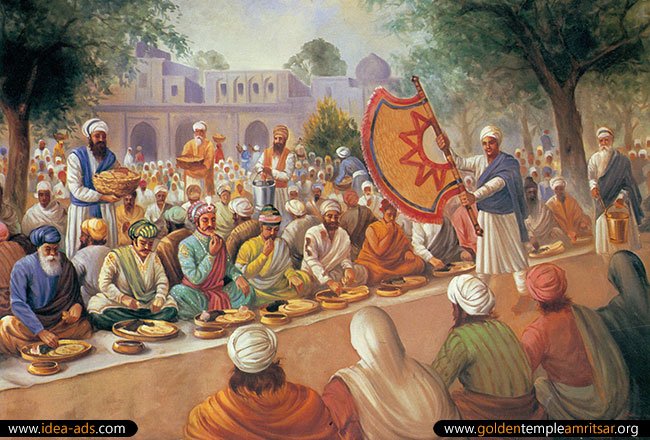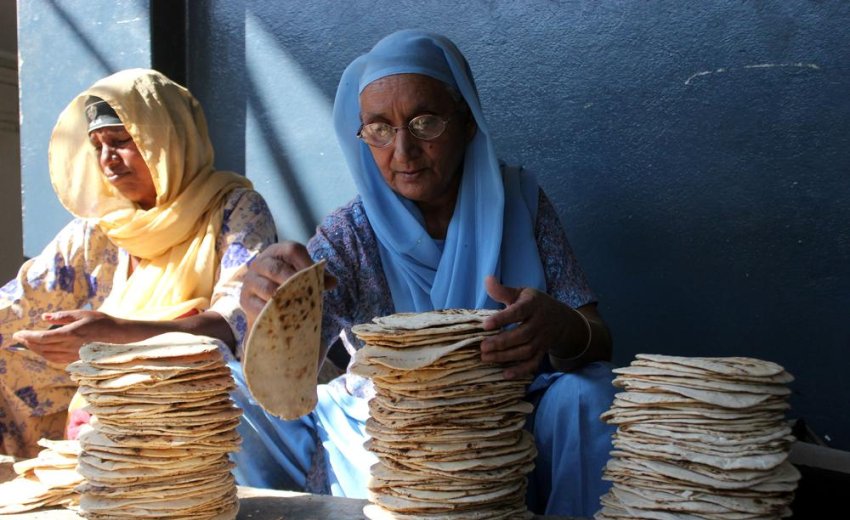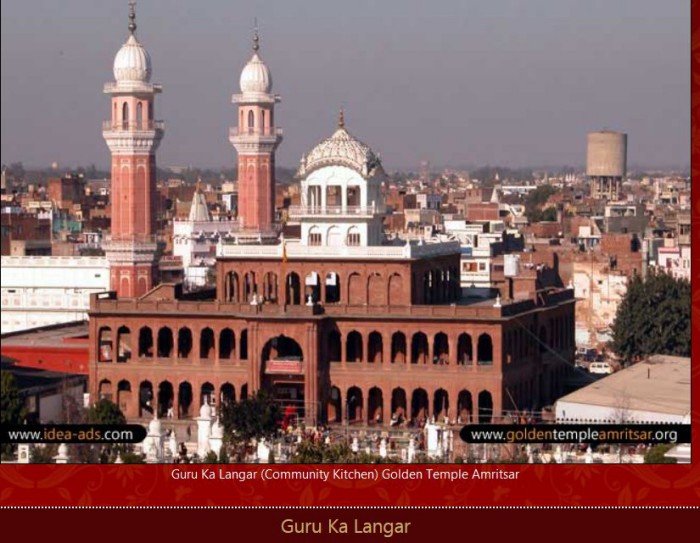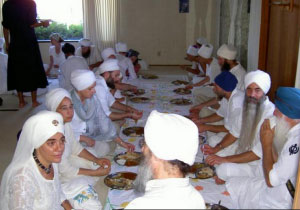 |
| Empror of India sharing the meals with his nobles and servants along with "Sangat" during his visit to Goindwal Sahib to have Darshan of Guru Amardas ...Guru Ka Langar @ Golden Temple Amritsar |
|
September 22, 2015: There are many memorable aspects of a Sikh Gurdwara program, but most first-time visitors are surprised and delighted by the wonderful food that is freely served to the congregation at the conclusion of every gurdwara program. This serving of food is a long-standing tradition called, Guru ka Langar (the Guru’s Kitchen) and originated with the first Sikh guru, Guru Nanak around 1521. Perhaps it began when, as a boy, young Nanak would feed groups of traveling mystics as they traveled through the area around his home. Or perhaps it grew out of Guru Nanak’s experiences traveling far and wide during his four Udasis (extended spiritual journeys) – being on the road, vulnerable to the varying level of hospitality that were available in all the locations he visited. Established at a time in India when separation by caste was of the highest importance, the act of sitting together (Pangat) in the Guru ka Langar was a revolutionary idea. “That is the maryaadaa (discipline) of langar – that even a king and a beggar can sit together, serve and eat the same food, in the same way” (Siri Singh Sahib Yogi Bhajan). Today, it is still a powerful reminder of the equality of all people before God, regardless of birth, gender, faith or status.
The food prepared in the Guru ka Langar is always vegetarian. It is prepared with the highest regard for hygiene and with an elevated consciousness by reciting Gurbani (the Guru’s words) during the preparation, cooking and serving. Although it is common to serve food based on Indian cuisine because most congregations are predominately of Indian origin, it is perfectly acceptable to serve good quality food based on any other cuisine or tradition. Before the food is served, a prayer (Ardas) is recited over the completed preparations and it is blessed with the passing through of a sacred knife (Kirpan). All people are welcome to the Guru ka Langar. It is normal to ask people to remove their shoes, cover their heads and sit on the floor in lines to be served. Clearly, Guru Nanak must have known the adage that the way to a man’s heart is through his stomach. This tradition of offering free food to anyone is grounded in the altruism and egalitarianism at the heart of Sikh beliefs. The virtue of “Vand Chakna” is one of the fundamental qualities of a Sikh; it means to share what you can with those in need. Also, the practice of Seva (selfless service to others) is also a highly valued virtuous activity in Sikh Dharma. The seva of serving Guru ka Langar has become widely associated with the identity of Sikhs and this noble tradition continues to this day all around the globe wherever there is a gurdwara or there are Sikhs. At the Harimander Sahib (the Golden Temple) in Amritar, which is the most revered of all Sikh gurdwaras, over 50,000 people are served in the Guru ka Langar every day, with over 100,000 people being served on popular holidays. At the 2004 World Parliament of Religions conference in Barcelona, Spain, Sikhs made a huge impression by serving Guru ka Langar to all the participants. It was a palpable manifestation of the virtues of diversity, humility and loving service to all.
Today, there are some people who look to the example of the Guru ka Langar as a way to ease the huge problem of hunger. Whether the hunger is caused by geo-political struggles or by social inequality, Guru Nanak’s Guru ka Langar demonstrates how when charity, humility and service lead the way, our humanity toward each other can overcome even the greatest challenges. When you are blessed to eat in the Guru ka Langar, you experience Cherdi Kala (the feeling of being lifted up) and Sarbhat da Bala (the loving intention of wishing the best for all people) and you realize that your stomach is not only being fed, but also your soul. By Pritpal Singh Khalsa, Director of Dharmic Education © Sikh Dharma International 2015 |



